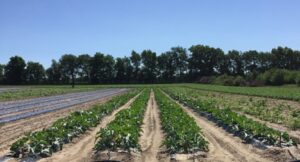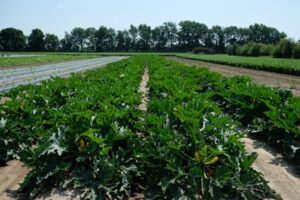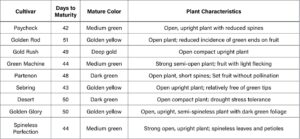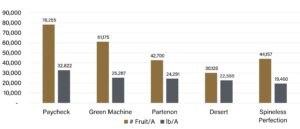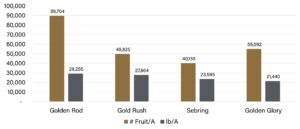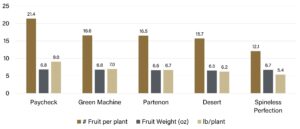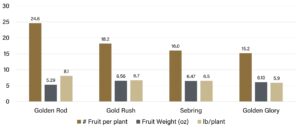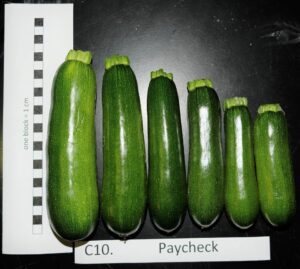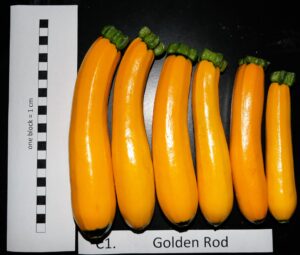I conducted a summer squash (zucchini) variety trial at the Throckmorton Purdue Agriculture Center/Meigs Horticulture Facility, Lafayette, IN, a few years ago (Figures 1 & 2).
We evaluated ten varieties with cylindrical fruit shape characteristics. (Table 1). Unfortunately, one variety, Felix, is no longer available. Standard zucchini production protocol was followed. Diseases and pests were managed by scouting and using recommendations from the Midwest Vegetable Production Guide. The yield was assessed three times a week between June 18 and July 18. Fruits were harvested when they reached 6 to 8 inches in length. For each plot, the marketable and unmarketable number of fruits was recorded. Fruit that was more than 8 inches long was classified as unmarketable.
The number of marketable fruit and yield per acre and fruit weight differences among entries were significant. Golden Rod produced the highest number of fruits per acre, 89,704 (Figure 3). However, the number of fruits per acre produced by Partenon, Spineless Perfection, Gold Rush, Golden Glory, Green Machine, and Paycheck was not significantly lower than Golden Rod and varied between 42,700 and 78,255. Sebring, Partenon, Green Machine, Gold Rush, and Golden Rod produced between 23,595 and 31,491 lb/A and were not significantly lower than the highest producer, Paycheck (32,822). Spineless Perfection produced the lowest number of fruit and yield per plant (Figure 4).
The fruit weight of all entries varied between 5.3 and 6.8 oz (Figures 5 & 6). Spineless Perfection (6.7 oz), Green Machine (6.8 oz), and Paycheck (6.8 oz) produced the heaviest fruit. However, the fruit weight of all other entries, except Golden Rod, was not significantly lower than the heaviest fruit-producing entries. The presence of disease and insects were very low and did not impact yield.
Unmarketable yield differences between entries were significant. Partenon produced the highest unmarketable yield, significantly higher than Golden Rod Green Machine, Sebring, Desert, and Golden Glory. The unmarketable yield of Paycheck, Gold Rush, and Spineless Perfection was not significantly lower than Green Machine. Besides the fruit being oversized, these entries were very strong producers. Marketable yields could have improved if these entries were harvested more frequently.
In summary
- The best-performing green zucchini squash entries were Paycheck (Figure 7), Green Machine, and Partenon.
- Golden Rod (Figure 8) and Gold Rush were the best-performing yellow zucchini entries.
- Be ready for a lot of fruit in a four-week period.
- I recommend walking the field every day if you are harvesting a specific fruit size.
- The fruit grows very fast, and what is not ready in the morning might be ready in the afternoon or the following day.
- If you do not have a market for large fruit, then cut them off the plant. Keeping the fruit attached will divert recourses and result in less new fruit.
For more detailed information about production practices that were followed, data, and pictures of fruit, visit the Midwest Vegetable Trial Report.
